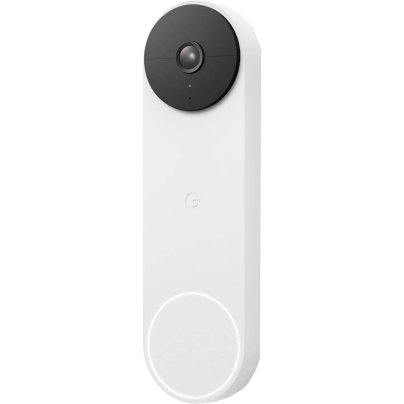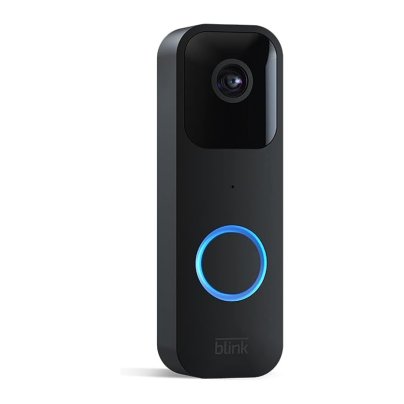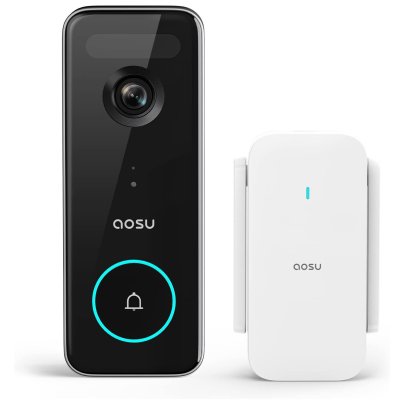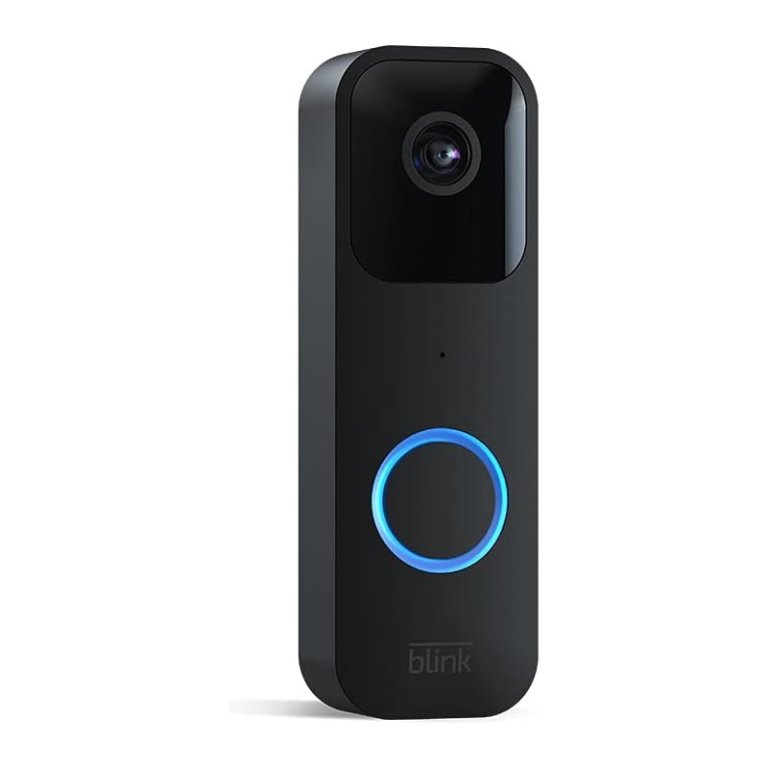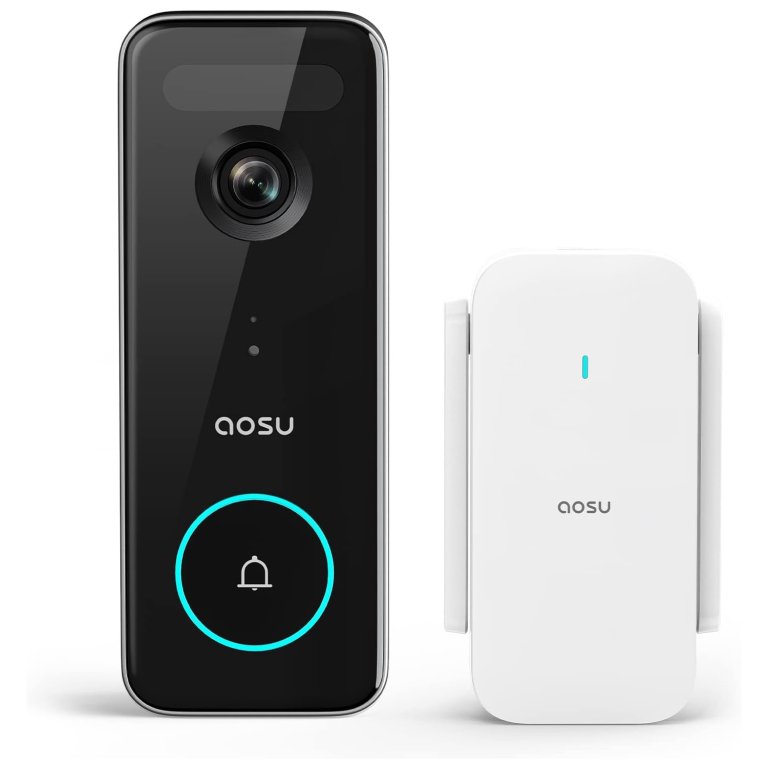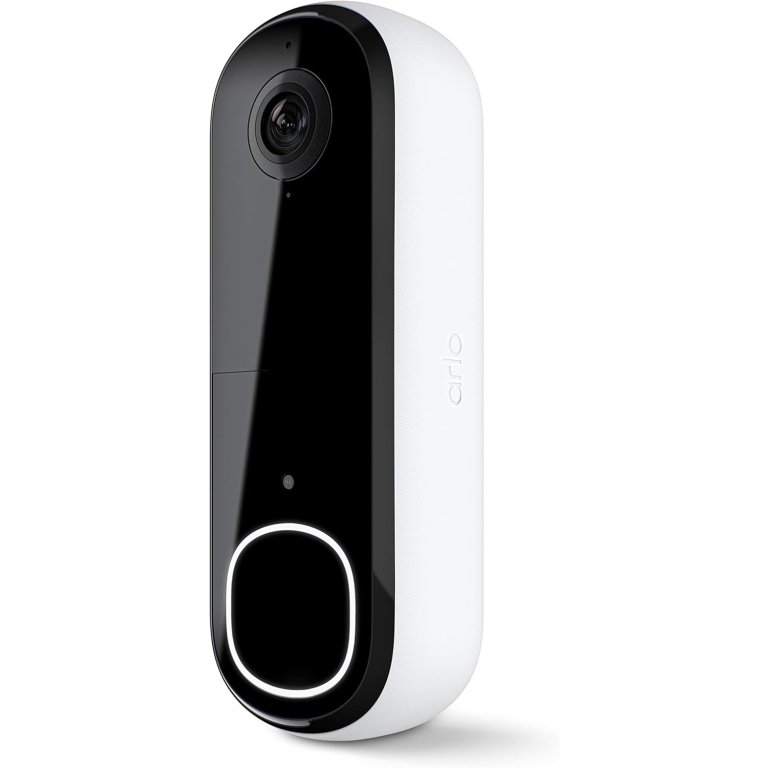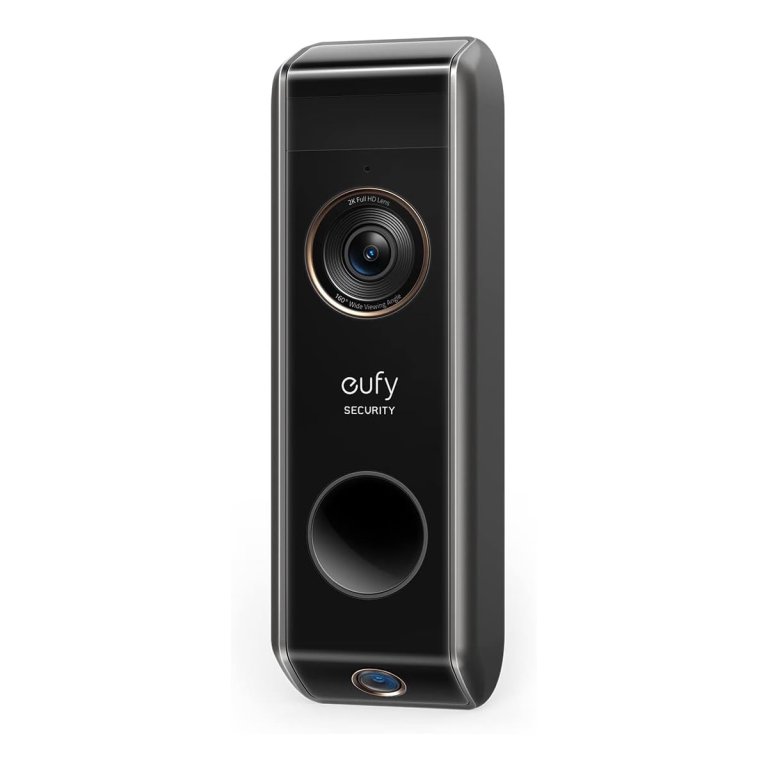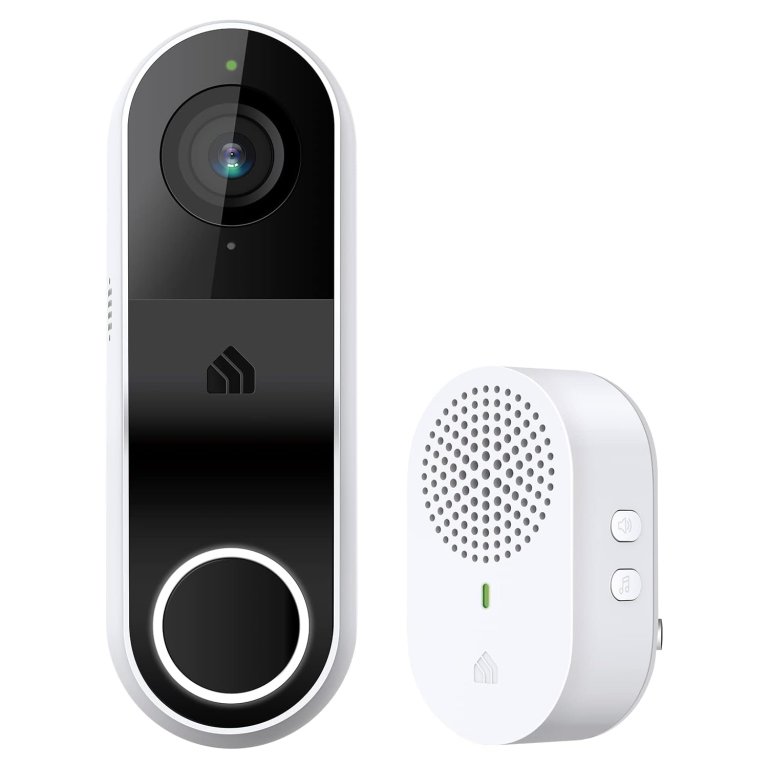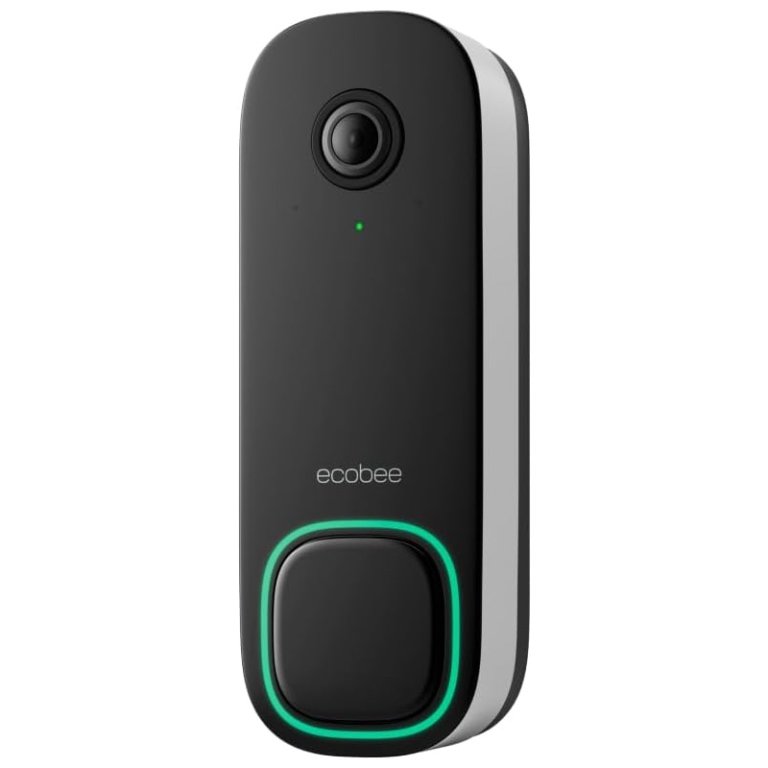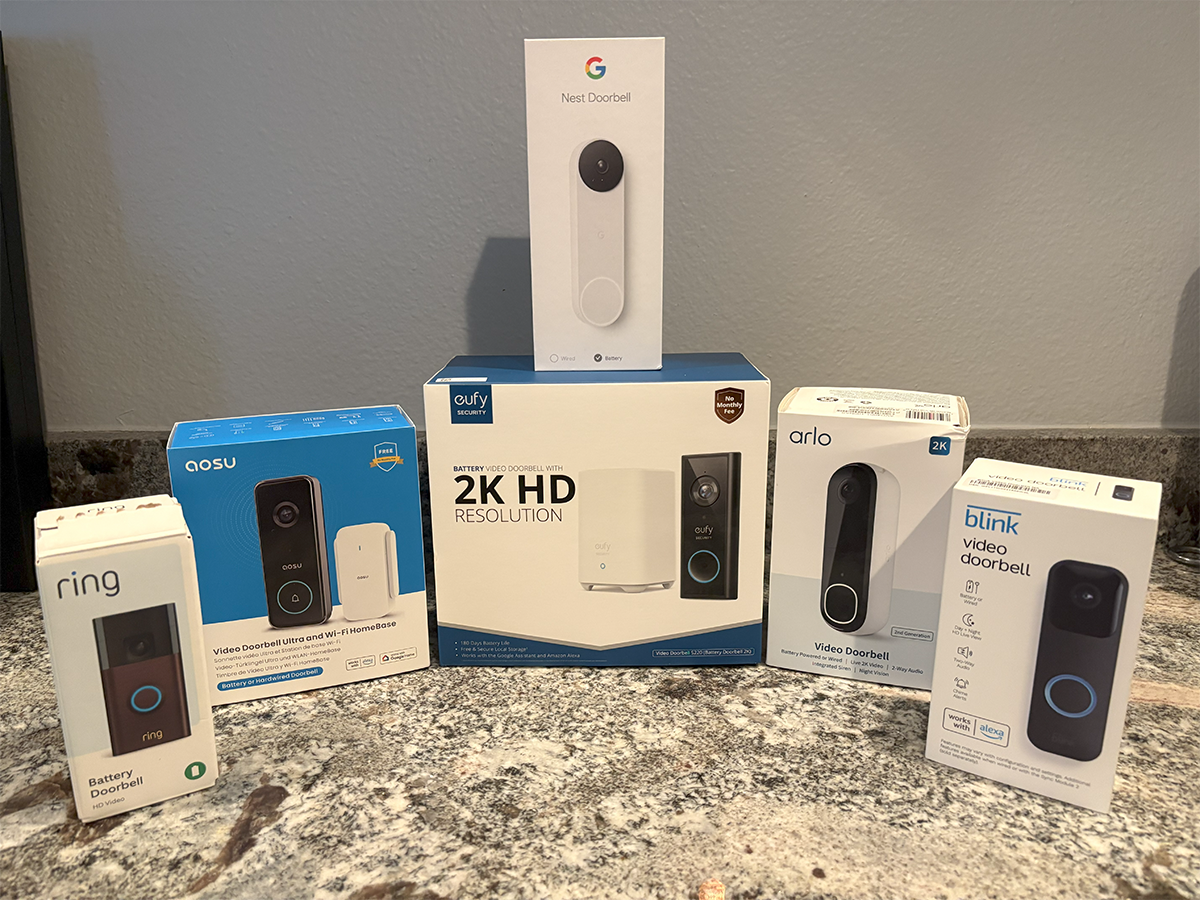
We may earn revenue from the products available on this page and participate in affiliate programs. Learn More ›
A video doorbell is an essential tool for anyone looking to boost their home security with the convenience of remote monitoring. These devices let you see, hear, and communicate with visitors at your door from your smartphone, whether you’re upstairs or across the country. Video surveillance doorbells are especially valuable for households that receive frequent deliveries, as many models alert you to packages left at your door and even distinguish between people, pets, and objects.
Finding a quality video doorbell is key to ensuring clear, reliable video feeds and notifications you can trust. With a crowded market of video doorbells offering varying features, choosing one that fits your needs can be challenging. To help, we tested seven popular models, evaluating their video quality, connectivity, ease of installation, and app functionality. We’ve also included additional picks that we researched thoroughly but haven’t tested. Out of all the models we tested, our top recommendation is the Google Nest Doorbell due to its exceptional video clarity, fast response times, and standout smart features like facial recognition.
Whether you’re interested in video quality, advanced security features, or ease of use, our list of the best video doorbells and our shopping tips will guide you toward the right one for your home.
- BEST OVERALL: Google Nest Doorbell
↓ Jump to Review - BEST BANG FOR THE BUCK: Blink Video Doorbell
↓ Jump to Review - BEST VIDEO QUALITY: Aosu Wireless Video Doorbell Ultra
↓ Jump to Review - BEST SUBSCRIPTION-FREE: Eufy Wireless Video Doorbell S220
↓ Jump to Review - EASIEST SETUP: Arlo 2K Video Doorbell – 2nd Generation
↓ Jump to Review - BEST HEAD-TO-TOE CAMERA: Eufy Video Doorbell S330 2K HD Security Camera
↓ Jump to Review - BEST WITH CHIME: Kasa Smart Video Doorbell with Chime
↓ Jump to Review - ALSO CONSIDER: Ecobee Smart Video Doorbell Camera
↓ Jump to Review
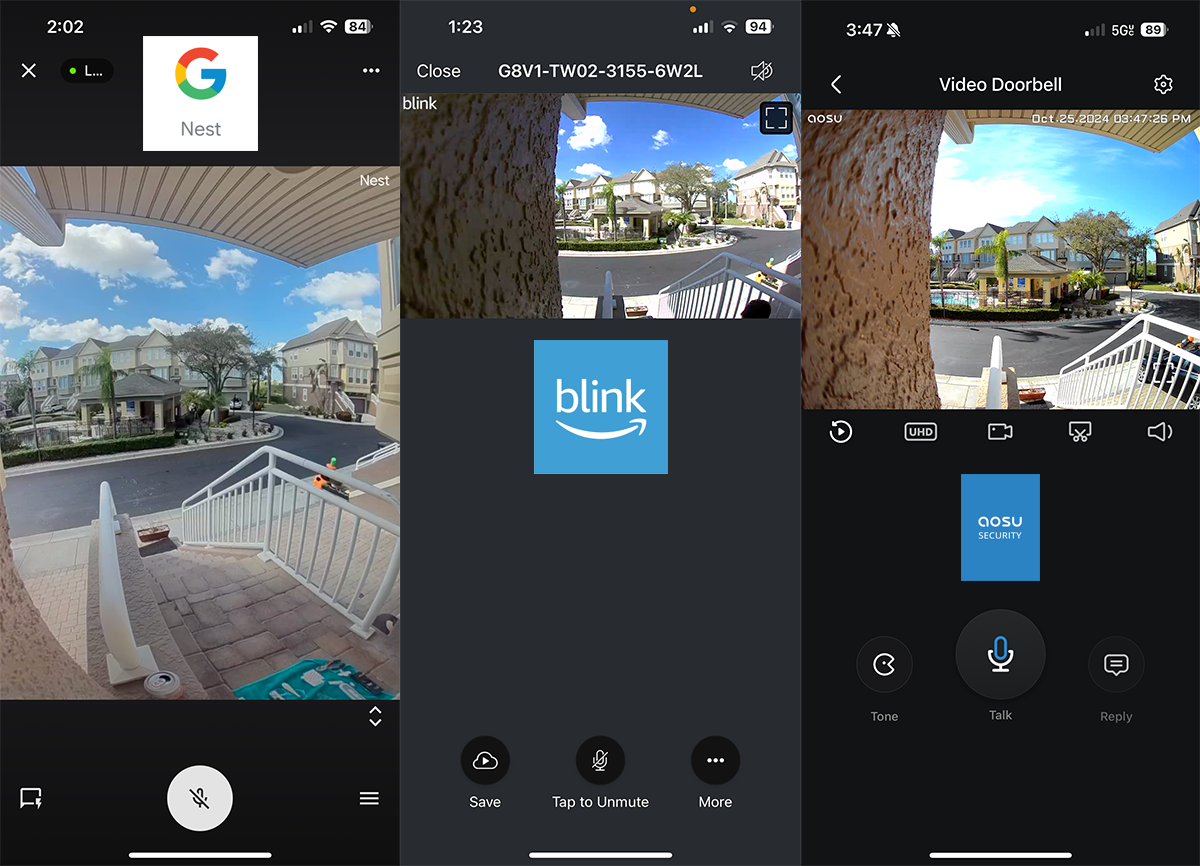

Testing Stats | |
| Products tested | 7 |
| Time spent testing | Two weeks |
| Tests performed | 6 |
| Price range | $50 to $145 |
Our Top Picks
These are the video doorbells we tested firsthand. Each stands out for different reasons, such as reliability, ease of use, and smart features. Our in-depth testing highlights the best performers for secure, convenient home monitoring.
Best Overall
Google Nest Doorbell
What We Like
- Sleek-looking design
- Very smooth installation
- Near-instant video response time
- Plenty of custom features
What We Don’t Like
- Premium price (but you get what you pay for)
Product Specs
- Installation: Wired or wireless
- Resolution: 1.3 megapixels (MP)
- Field of Vision: 145 degrees diagonal, 3:4 aspect ratio
- Subscription: Free/Nest Aware/Nest Aware Plus
Our Ratings: Installation & Setup 5/5; Functionality 5/5; Picture Quality 5/5; Value 5/5
The Google Nest Doorbell offers an unbeatable blend of intelligent features, user-friendly design, and reliable video performance, making it our top pick. It’s easy to install with only two screws needed to secure the baseplate—no technical expertise required. After the baseplate is up, the doorbell clicks snugly into place, and setup via the Google Home app is a breeze, taking just about 20 minutes from start to finish.
To use the Nest Doorbell, you’ll need a Gmail account, which syncs seamlessly with the Google Home app for managing settings and viewing footage. Its video history stores the last three hours of events, and it also features a quick-charging system. A provided tool lets you easily remove the doorbell, and pressing the button while it charges activates the voice assistant to give you a countdown on the charge time remaining. And for those who prefer a hardwired setup, it’s compatible with existing doorbell wiring.
The basic features work for free with no subscription, which is great—a video doorbell without subscription costs is an ideal way to check out the technology before committing to a monthly cost. Alternatively, Nest Aware subscribers ($8 per month or $15 per month for Plus) can unlock a suite of premium features, including custom activity zones, familiar face recognition, and even smart alerts for smoke, carbon monoxide, or breaking glass sounds.
During testing, this Wi-Fi doorbell’s near-instant video response time set it apart. Unlike others with a noticeable 2-4 second delay, this one had almost no lag. Convenient preset voice responses conveniently facilitate communication with visitors at the tap of a button. And customization of the sound of the doorbell with seasonally themed options for holidays like Halloween or Diwali add charm and festivity to the entryway.
On top of all that, the sleek, modern design of the Google Nest Doorbell is second to none, adding both security and style to the entryway. There is also a wired-only model you can opt for instead, which is a little smaller since it doesn’t need a large battery. Both models are available in four gorgeous colors (snow, linen, ash, and ivy). All are smooth, sleek, and look great. This really was the best-looking video doorbell we tested by far.
What our tester says: “This is hands down the best video doorbell in the market right now. Not only is it simply beautiful to look at, it’s also packed with cool features and has excellent sound and video quality. Of all the models I tested, this is the one I’m keeping on my front door.” —Paul Rankin, Product Reviews tester and writer
Get the Google Nest doorbell at Amazon, The Home Depot, Walmart, Best Buy, or Google.
Best Bang For The Buck
Blink Video Doorbell
What We Like
- Clear sound quality
- Very quick 10-minute installation
- Works especially well with Amazon Alexa
What We Don’t Like
- Only brand to not include a wedge mount
Product Specs
- Installation: Wired or wireless
- Resolution: 1080p High Definition (HD)
- Field of Vision: 135 degrees horizontal, 80 degrees vertical
- Subscription: Free/Blink Basic/Blink Plus
Our Ratings: Installation & Setup 5/5; Functionality 4/5; Picture Quality 3/5; Value 3.7/5
When we tested the Blink Video Doorbell, we found it incredibly easy to set up. Everything was ready to go in under 10 minutes, and installing it wirelessly was a breeze—just two screws in the wall, then click it onto the mounting plate. Running on two batteries, it’s a low-maintenance option that pairs seamlessly with Amazon Alexa devices, thanks to Blink being Amazon-owned.
The two-way speaker system worked well, providing clear sound both ways. The doorbell speaker is loud enough to be easily heard, and we received prompt smartphone notifications via the Blink app each time someone rang the bell or triggered the motion sensor. We also appreciated the ring around the doorbell button, which glows blue whenever someone views the camera feed—an unobtrusive but useful feature.
Basic service is free. With a Blink subscription, you get a variety of useful add-ons. Both the Blink Basic ($3 per month) and Blink Plus ($10 per month) plans offer unlimited video storage, recurring snapshot captures throughout the day, and person detection for more relevant alerts.
Unfortunately, the Blink does not come with a wedge mount, which limits placement flexibility for optimal views. It’s the only video doorbell we tested that did not include a wedge. Also, we couldn’t view a live feed without either hard-wiring the doorbell or with the optional purchase of the Blink Sync Module, which was a letdown. However, the overall performance, ease of installation, and Amazon Alexa integration make it a solid choice for those seeking a reliable, budget-friendly video doorbell.
Get the Blink video doorbell at Amazon, Lowe’s, or Walmart.
Best Video Quality
Aosu Wireless Video Doorbell Ultra
What We Like
- Fantastic UHD video quality
- Plug-in Wi-Fi booster works great
- No subscription needed
What We Don’t Like
- Bit of a generic design
Product Specs
- Installation: Wired or wireless
- Resolution: 5MP Ultra High Definition (UHD)
- Field of Vision: 166 degrees
- Subscription: None
Our Ratings: Installation & Setup 5/5; Functionality 5/5; Picture Quality 5/5; Value 4.7/5
Testing the Aosu wireless door camera was a pleasant surprise; it’s a high-quality, feature-rich option from a lesser-known brand that performed impressively well. The standout feature is the 5MP UHD camera, which offers incredible video clarity—it’s the best video quality we’ve seen on any doorbell camera. With a 166-degree field of view, we could see visitors head-to-toe and check for packages on the ground without any blind spots.
Installation took just 20 minutes, and we had the option to go wireless or wired, which we found convenient. The app worked seamlessly, offering instant connection and perfect notification balance—no spam alerts, just the updates we needed. Aosu’s doorbell also works with both Alexa and Google Assistant, making it easy to integrate into any smart-home setup.
One major advantage with Aosu is the free storage: the system stores 60 days of loop recording at no extra cost, which is a refreshing change from most brands that charge subscription fees. The Wi-Fi home base is another highlight, as it plugs into a wall outlet and stabilizes the connection—a huge plus if Wi-Fi around your front door is inconsistent. With motion detection and clear night vision, this camera covers all the essentials, and the responsive app interface made using it a breeze. Aosu has delivered a quality doorbell camera with top-notch video, solid app integration, and valuable extras that make it well worth considering.
What our tester says: “I was so pleasantly surprised by the Aosu doorbell. From an obscure brand I’d never heard of comes the best video quality we’ve ever seen in a doorbell. Paired with the plug-in Wi-Fi booster and chime, this is an all-around fantastic video doorbell.” —Paul Rankin, Product Reviews tester and writer
Get the Aosu video doorbell at Amazon, Walmart, or Aosu Life.
Best Subscription-Free
Eufy Wireless Video Doorbell S220
What We Like
- All the features, no subscriptions
- Videos are encrypted and stored locally
- Lots of custom controls in the app
What We Don’t Like
- Slight delay when accessing the live feed
Product Specs
- Installation: Wired or wireless
- Resolution: 2K HD
- Field of Vision: 4:3 aspect ratio
- Subscription: None
Our Ratings: Installation & Setup 5/5; Functionality 4.8/5; Picture Quality 4.5/5; Value 4.3/5
Setting up the Eufy Video Doorbell took a bit more time than some other models we’ve tested, as it includes a home base in addition to the doorbell itself. The setup process took around 30 minutes before we even started mounting the doorbell, but the app provided helpful guidance along the way. We liked the futuristic, R2D2-style chimes from the home base when pairing new devices—it added a fun touch to the setup process.
Once everything was paired, the Eufy app played a short 4-minute video to walk us through the installation, followed by detailed slides with pictures. The instructions were clear, and mounting was straightforward. We were impressed by the 2K HD video quality with a 4:3 aspect ratio, which provided a full view of visitors and anything on the doorstep. The 16 gigabytes of local encrypted storage is a huge perk, as it offers plenty of secure storage without the need for cloud subscriptions.
The live feed was accessible after waiting a few seconds for it to load, and we appreciated the in-app controls, allowing us to screenshot, record, or reply at the touch of a button. The audio quality from the doorbell’s microphone was crystal clear, and we liked the quick-response options, which include three default responses and the ability to add our own. While the app is a bit heavy on pop-ups and ads, once we navigated to the camera view, it was user-friendly and effective. Eufy’s encrypted local storage, combined with great video quality and thoughtful motion detection options, makes this a strong pick for those seeking added security and privacy.
Get the Eufy S220 video doorbell at Amazon or Eufy.
Easiest Setup
Arlo 2K Video Doorbell—2nd Generation
What We Like
- Step-by-step install instructions
- Live feed is quick to connect
- Motion alerts are instant
- Custom activity zones for better notifications
- Integrates with Apple Home
What We Don’t Like
- Free version quite limited compared to the subscriptions
Product Specs
- Installation: Wired or wireless
- Resolution: 2K HD
- Field of Vision: 180 degrees
- Subscription: Free/Basic/Plus/Premium
Our Ratings: Installation & Setup 5/5; Functionality 4/5; Picture Quality 3.5/5; Value 3.8/5
Setting up the Arlo 2K video doorbell was quick and straightforward, taking just under 20 minutes with the Arlo Secure app’s step-by-step guidance. We were able to choose between installing the doorbell battery-powered or wired, and the app’s instructions were clear and easy to follow—honestly, the best we’ve encountered in a doorbell setup.
Once we installed it, we appreciated how easy it was to connect to the live feed and start receiving motion alerts instantly. The 30-day free trial of Arlo Secure allowed us to explore features like 2K video recording, custom activity zones, advanced object detection, and interactive notifications. These extras made a noticeable difference in keeping us informed of relevant activity, and we could set up specific zones to eliminate notifications for passing cars or distant foot traffic. The Arlo Secure app also includes an Emergency Response feature, which is reassuring. As an added bonus, it integrates seamlessly with Apple Home products
Without a subscription, the doorbell’s capabilities are quite basic. However, the paid plans are affordable: Basic at $6.67 per month, Plus for $15 per month, and Premium for $20.83 per month, all billed annually. Subscriptions unlock emergency response, cloud storage, smart activity zones, and enhanced object detection, which really elevate the functionality.
For reliable security with clear video and strong app features, Arlo’s 2nd Gen doorbell is a solid choice, especially if you plan to invest in a subscription for enhanced features.
Get the Arlo video doorbell at Amazon, Walmart, Sam’s Club, Best Buy, or Arlo.
Best Head-To-Toe Camera
Eufy Video Doorbell S330 2K HD Security Camera
What We Like
- No wiring or outlet required
- Quickly syncs to wireless network
- Motion-detection alerts
- Human and pet detection
- Dual cam senses packages at door
What We Don’t Like
- Requires periodic removal from case and recharging
Product Specs
- Installation: Wired or wireless
- Resolution: 2K HD
- Field of Vision: 160 degrees (dual camera for top and bottom)
- Subscription: None
Our Ratings: Installation & Setup 5/5; Functionality 4.5/5; Picture Quality 5/5; Value 4.5/5
The Eufy S330 video doorbell comes with comprehensive coverage and smart detection features. Installation is a breeze: we simply attached the exterior case to the door frame, inserted the doorbell unit, and synced it to the Wi-Fi. With an impressive head-to-toe view, it easily captures everything from a visitor’s face to packages on the porch, giving full coverage of the entryway.
One of the highlights of the Eufy S330 is its dual-camera setup, which includes a second lens dedicated to monitoring packages. The app’s motion notifications are precise and customizable, even distinguishing between humans and pets with alerts like “Human detected” or “Pet detected.” As a full-featured security tool, it allows live views of the door area at any time, while the “Events” tab conveniently compiles all motion-activated clips for easy review.
The rechargeable battery offers flexibility, though it needs charging every 3 to 4 weeks. A small magnetic key is used to remove the unit, adding a layer of security against theft. While this key is essential, it’s worth noting that misplacing it could cause a bit of hassle. All in all, the Eufy S330’s clear, wide-angle coverage and effective notifications make it an exceptional choice for those seeking thorough entryway monitoring.
Get the Eufy S330 outdoor security camera at Amazon or Eufy.
More Great Options
Here are a few more video doorbells that stood out based on their impressive features and positive user reviews. Though we haven’t tested these ourselves, they come highly recommended as reliable, high-quality options.
Best With Chime
Kasa Smart Video Doorbell with Chime
What We Like
- Budget-friendly price
- Good audio from the indoor chime
- Interesting angular design
What We Don’t Like
- Must be hardwired
Product Specs
- Installation: Wired only
- Resolution: 3MP HD
- Field of Vision: 160 degrees
- Subscription: Free/Plus/Premium
The Kasa Smart Video Doorbell combines impressive video quality with decent smart-home integration, making it a standout choice for modern security needs. With 2K resolution and a wide 160-degree field of view, this doorbell ensures you capture every detail of your front entryway, from visitors to packages. It seamlessly integrates with popular smart-home systems, including Alexa and Google Home, allowing for convenient voice control and notifications.
Designed for hard-wired installation, the Kasa Smart Doorbell comes with a plug-in chime, so you’ll never miss a visitor. Real-time person and motion detection features provide instant alerts to your smartphone, keeping you informed about activity at your door. Plus, with the Kasa Care subscription, you can store footage for up to 30 days, whether you prefer local or cloud storage—starting at just $3 per month.
The Kasa Smart Video Doorbell is an excellent option for anyone looking to enhance their home security with a high-resolution camera and advanced features, ensuring peace of mind whether you’re at home or away.
Get the Kasa video doorbell at Amazon.
Also Consider
Ecobee Smart Video Doorbell Camera
What We Like
- Great field of vision
- Excellent 2-way audio quality
- IP65 waterproof
What We Don’t Like
- Subscription-free plan has limited features
- Hard-wire install only
Product Specs
- Installation: Wired only
- Resolution: 1080p HD
- Field of Vision: 175 degrees vertical
- Subscription: Free/Standard/Complete
The Ecobee Smart Video Doorbell is designed to elevate your home security with its advanced detection capabilities and wide-angle coverage. Featuring a wired-only installation, this doorbell seamlessly integrates into your existing setup while providing a head-to-toe view of your entryway.
One of its standout features is its ability to distinguish between people, packages, and other objects, allowing you to receive tailored alerts about what’s happening outside your door. However, to unlock these advanced detection features, an Ecobee Security Subscription is required. The standard plan is available for $5 per month, while the complete plan is priced at $10 per month. The free plan offers limited functionality, losing the 30-day video history and omitting package detection, push notifications, and 24/7 professional monitoring.
With the Ecobee Smart Video Doorbell, you can stay connected to your home with real-time alerts and video feeds directly to your smartphone. Its sleek design and advanced capabilities make it an excellent addition to any smart-home setup, ensuring that you never miss a visitor and always have a clear view of your front entrance. Whether you’re at home or on the go, the Ecobee Smart Video Doorbell keeps you informed and in control.
Get the Ecbobee video doorbell at Amazon, The Home Depot, Walmart, Sam’s Club, Best Buy, or ecobee.
ALSO TESTED
While the Ring Battery Doorbell offers easy setup and eco-friendly packaging, it fell short in our testing. Its limited video quality and small field of view, combined with connectivity issues at our tester’s front door, prevented it from making our recommended list. It’s a budget-friendly choice but may not perform well in homes with spotty Wi-Fi.
Jump to Our Top Picks
How We Chose and Tested the Best Video Doorbells
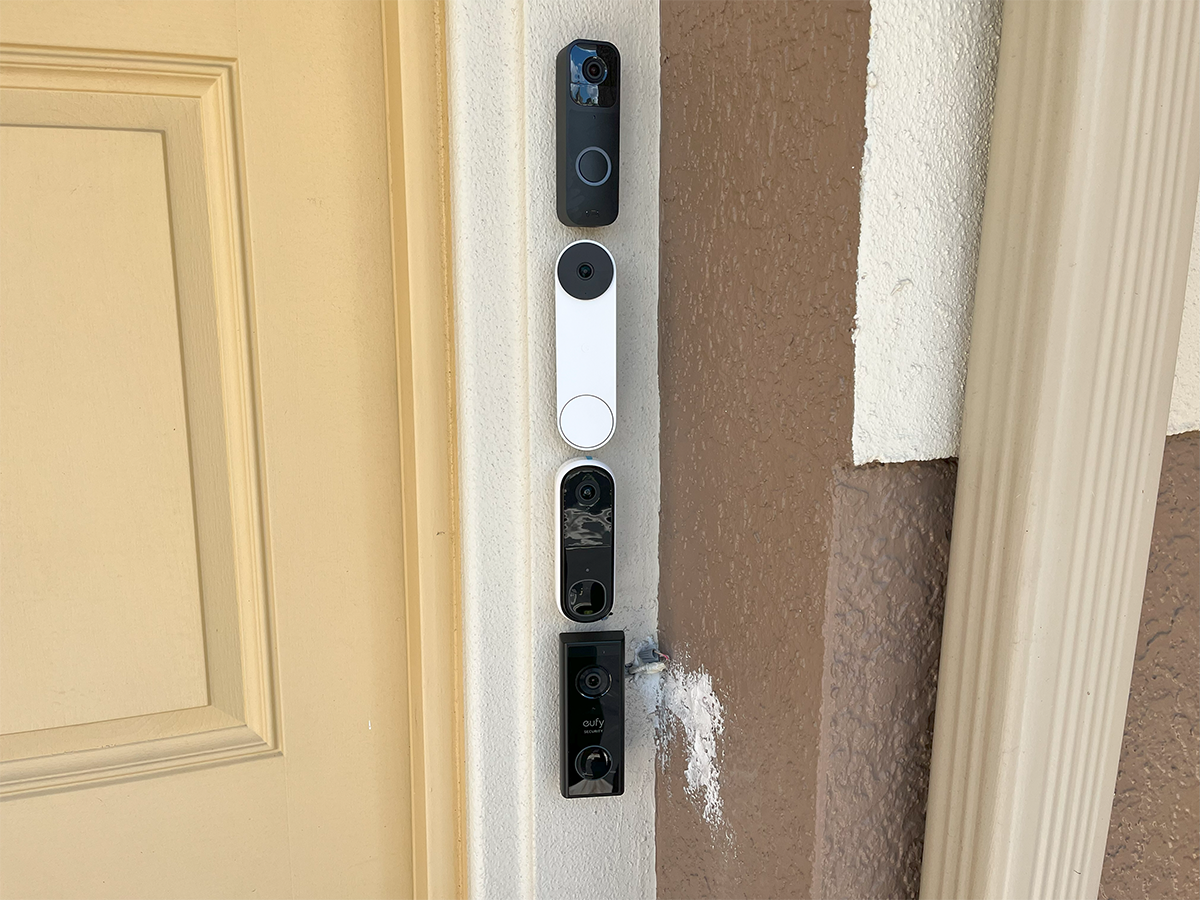
When selecting video doorbells to test, we researched popular and highly rated models known for features like 2K resolution, field of view, and advanced motion detection. We prioritized doorbells with unique qualities—such as head-to-toe visuals, app customization, or innovative motion alerts—that could offer the best user experience and performance.
For the testing process, we focused on setup ease, video quality, connectivity, and overall functionality. Each model’s installation was timed and noted for simplicity, including how quickly it connected to Wi-Fi. Once each was installed, we evaluated video clarity in varying lighting conditions and checked each doorbell’s field of view to ensure comprehensive coverage. Connectivity was a key factor; we tested how quickly each doorbell responded to motion alerts and the live feed function, especially when used with a weaker Wi-Fi signal.
In terms of motion detection, we assessed accuracy in differentiating between people, animals, and packages. Models offering customizable activity zones and personalized alerts were rated higher. Final scores were based on consistency across all categories, focusing on video quality, reliable notifications, and user-friendly app experiences.
What to Consider When Choosing a Video Doorbell
Most people who buy video doorbells do so to improve their home security systems. Video doorbells are equipped with a range of features that protect the user’s home. Many double as video cameras and have motion detectors, video recording, or continuous monitoring to keep tabs on activity at the front door. Read on to learn more about the key features to look for in the best video doorbells.
Wired vs. Wireless
Video doorbells are sold in both wired and wireless configurations. The best choice for a home depends on a shopper’s existing setup and needs.
Many traditional doorbells are hard-wired into the home’s electrical system with a circuitry system that connects them to a power source and the chime. Though wired video doorbells can usually be connected to the existing doorbell and chime system, installing them can be challenging. It is important to confirm whether the old system’s voltage matches that of the new video doorbell. If the old system can’t support the video doorbell, the circuit may need to be upgraded.
Wireless doorbell cameras are easier to install. They do not need to plug into a system, so there’s no circuitry to deal with, and most can be set up in minutes. These doorbells can be placed almost anywhere. The only real downside is that their battery needs occasional recharging and may eventually need to be replaced.
Smart-Home Integration
Some simpler video doorbells are stand-alone devices, but others can be connected with smart-home systems. These smart doorbells have a range of integrative features. For example, when someone rings the doorbell, the user can opt to receive a notification on a smartphone, smart TV, tablet, or even smart fridge. Smart doorbells can also connect to other smart-home devices, such as front door locks, porch lighting, or alarm sirens. Smart-home programs can be set up so that these products interact with each other.
Another cool thing about smart doorbells is that many models can be controlled by smart voice features, such as Amazon Alexa or Google Home. Before choosing a smart video doorbell, users will want to make sure that their choice is compatible with the current smart-home system.
Doorbell Connectivity
Because smart-home tools are growing more and more popular, almost all video doorbells have some degree of smart connectivity. These features allow the doorbell to send notifications, store captured videos, and integrate with smart-home systems.
Video doorbells can connect via a hardwired connection, Ethernet connection, Wi-Fi connection, or Bluetooth. Most popular video doorbells connect via Wi-Fi, specifically 2.4GHz Wi-Fi, though some dual-band Wi-Fi doorbells connect to both the 2.4GHz and 5GHz bands.
One of the benefits of having a W-Fi–enabled video doorbell, of course, is that it works in concert with the doorbell’s mobile apps, which allows users to view live and stored video of the front door camera area from their smartphones. This convenient feature also notifies users of activity at the front door—when a package is delivered, for example, or if security concerns arise.
Resolution and Field of Vision
Generally speaking, the higher the resolution of a camera, the sharper the image; this is true of cameras, smartphones, and video doorbells. Most high-quality video doorbell cameras have a 1080p, full high-definition resolution. Perhaps the best reason to seek out a video doorbell with camera access, especially a high-quality camera, is to make sure that in the event of any security concerns at home, the video doorbell can provide a clear image of everyone who entered the area.
Video doorbell camera resolution can range from 480p to 2K, which is a step up from 1080p. Generally speaking, higher-resolution cameras are also more effective in low-light conditions and can capture images at greater distances.
“Field of vision” refers to how wide an area the camera can view. A video doorbell provides a much wider field of vision as compared to that of a peephole. Some video doorbells have narrow fields of vision—as narrow, perhaps, as 90 degrees. Shoppers should instead seek out products with a full 180-degree field of vision. A wide field of vision means users might even be able to monitor areas beyond the front door, such as the front porch or yard.
Recording and Storage
When it comes to how much and how long video doorbells record and when they start recording, video doorbells vary greatly. Some doorbells will record only a short clip following a doorbell ring, while others record continuously. The most common are video doorbells that have activated recording systems. These models begin recording when a particular action occurs, such as someone ringing the doorbell or setting off the motion detector.
As another attractive security feature, some video doorbells allow users to save and view videos later. These videos are typically either stored locally or in the cloud. Local storage means the video is saved locally to a hub device, a connected video recorder, or a removable microSD card. To access the recording, users must physically access the local storage device.
Video doorbells with cloud storage securely store users’ footage online. Cloud storage is usually provided by the manufacturer, either for free or with a subscription plan, and users can access the videos from anywhere with an internet connection. Some video doorbells have both local and cloud storage options to give users the peace of mind that there’s always a backup of security videos.
Additional Features
Many video doorbells do more than just notify users when the doorbell rings; they also have motion-detection settings that activate the camera when there’s movement in front of the doorbell. This feature is useful for alerting the user to any visitors, wild animals in the yard, package deliveries, or security concerns.
To prevent accidental triggers to the motion detector from things such as wind, leaves, and birds flying by, some doorbells are designed to let the user adjust the field of vision and sensitivity of the motion detector. When the motion detector is triggered, most video doorbells with this feature will notify or record the activity.
Night vision is another feature that users should research before purchasing a video doorbell. Models with night vision automatically activate once it is dark outside and provide good video quality at night. This is a terrific feature to have for those who want extra security coverage at night, especially because a video doorbell may be a theft deterrent as well. For example, if there’s a rash of nighttime car burglaries in the neighborhood, the doorbell may deter the burglars, or at least capture them on camera.
Two-way audio is another convenient feature users may want in a video doorbell. Some products have a built-in speaker and microphone that provides the ability to communicate with the person at the door. This feature comes in very handy when, say, the user is away from home and wants to instruct the delivery person to leave a package, or if the user is home but indisposed.
Paid Security Plans
A doorbell that monitors the porch area and allows the user to “answer” the front door from a smartphone is a boon to a home’s overall security plan. Users looking for home protection beyond the helpful features already discussed might find it worthwhile to investigate video doorbells with opt-in, paid security plans.
Video doorbells can store photos and videos locally or via cloud-based storage. Most of the time, there are additional costs associated with cloud-based storage. Basic plans offer subscribers limited cloud storage and erase videos after a day or a couple of weeks. Premium plans may offer longer-term storage, perhaps for a month or more, or even unlimited cloud access to doorbell videos. These cloud-based plans are easily accessible and can be checked anywhere via a smart device and internet connection.
Premium security plans might also include more cameras and added security features. Some of these plans unlock extra camera features, like adding custom detection zones or face alerts. Those who are particularly concerned about home security should look into video doorbells that function as part of alarmed security systems for homes. These plans may include 24/7 professional monitoring to provide a second set of eyes on one’s property.
Installation
How easily a video doorbell’s installation goes depends on the type of doorbell a shopper gets. Wireless doorbells are easier than wired doorbells to install. Wireless models can be mounted with adhesive tape or with a drill and mounting hardware, with the latter being the more secure option.
Wired doorbells can be complicated to install because they have to be connected to the existing doorbell wiring or a new circuit. When connecting to existing wiring, installation is simple enough; confident DIYers should be able to take on the task. If a new circuit or brand-new wiring is required, a licensed electrician will need to step in, which involves an additional expense beyond purchasing the doorbell.
FAQs
For adequate footage, consider a video doorbell with at least a 720p HD resolution. Many high-quality video doorbells have a 1080p resolution, which is full HD quality. HD cameras offer clear video quality that can capture details.
Wi-Fi is not required to use a wireless doorbell. However, you may not be able to take advantage of all the doorbell’s features, like cloud storage and live viewing, without Wi-Fi connectivity. Some doorbells will still chime or record events to a local storage device when they are not connected to Wi-Fi.
It depends on the model. Most doorbell cameras only record when the doorbell is pressed or when its camera detects motion. If you prefer a video doorbell that will record around the clock, look for a model that offers continuous video recording.
Setup depends on the doorbell type. Wired doorbells need to be mounted and wired into the home’s electrical system. Wireless doorbells do not require any wiring, but they do need to be mounted. After installation, follow the manufacturer’s instructions to connect the doorbell to the home Wi-Fi network, doorbell hub, or other monitoring device.
Privacy concerns, occasional connectivity issues, and potentially costly subscriptions for cloud storage can be downsides of doorbell cameras.
Yes, video doorbells add both convenience and security, letting you see and communicate with visitors remotely.
No, some offer free basic features, but advanced features often require a monthly fee.
It depends on your needs. A video doorbell offers visitor alerts and two-way audio, while house security cameras provide broader property coverage.
Meet the Tester
Paul Rankin is a Scotland native now living in New York City. He started writing for BobVila.com in 2021, focusing on buyer’s guides for the full range of tools, furniture, DIY supplies, and home and garden products.
Additional research provided by Jasmine Harding.
